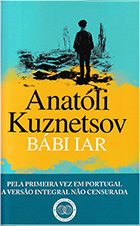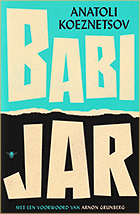Anatoly Kuznetsov
Babi Yar. A documentary novel
Proposal
Rights acquired by
- Matthes & Seitz, Germany
- Acantilado – Quaderns Crema, Spain
- Adelphi Edizioni, Italia
- Can Publishing, Turkey
- Porto Editora, Portugal
- De Bezige Bij, Netherlands
- Leidykla LAPAS, Lithuania
- Cappelen Damm, Norway
- Subhavi Publishers, Sri Lanka
Very few memoirs of the war seen through the eyes of a child have been preserved. This documentary novel stuns readers with its impartiality and openness, sometimes bordering on childish naivety and even brutality. It describes the experiences of a child during the Nazi occupation of Kiev in 1941-1943.
Ukraine had not yet recovered from Stalin’s Holodomor (forced famine) when it became easy prey for Hitler’s army. During the retreat of the Soviet troops from Kiev, the author’s grandfather, who had gone hungry all his life and hated the Soviet regime, waited like many others for the Nazis as liberators from the Bolshevik horror. On 20 September 1941, the German troops entered Kiev, and on the 24th at the order of the Red Army command, many old buildings on Kreshchatik in the historical centre of Kiev were blown up, where the headquarters of the German army, the commandant’s office and a hotel for officers were located. The next day, two thousand announcements were posted calling for all the “yids” of Kiev to appear with their documents, warm clothes and valuables (supposedly to be sent away to work, but if so why did they need to take their possessions?), or else they would face execution. But instead of being sent away, they found themselves on the outskirts of Kiev, in a place called Babi Yar. According to the report of the command of the division of Einsatzgruppe “C” of Sonderkommando “4A”, on 29 September 1941 alone, 33,771 Jews were executed in Babi Yar.
Tolya (Anatoly Kuznetsov) lived on the outskirts of Kiev in the district of Kurenevka, next to Babi Yar. Every day he heard bursts of machine-gun fire, saw the Nazis burning corpses, and the earth writhing with people who were still alive. During these years, the first version of the book was written – the only documentary evidence of the tragedy that took place in Babi Yar. It is a document of incredible power. Tolya even kept the thick notebook hidden from his family.
Of course, this is also a book about the hard life of a boy born into a poor family, which was divided by its attitude to the Soviet regime and God, to the communists and the fascists. He was always hungry and ready for adventures: whether he was looting shops during the entry of the fascist troops into Kiev, engaged in speculation of everything that could be sold on the market, or working in an underground sausage factory, where sausage was even made from human flesh. He is cunning, like any hungry teenager, but also naïve, like a child. When he discovers that all the Jews are being sent “to Palestine”, as everyone thought at the time, he regrets losing his friend Shurka, nicknamed Matsa, but he also thinks with malicious joy: “that’s what he deserves, he never gave any of my books back to me”. Then he realized for the first time that people were also divided by ethnic group – many “half-breeds” studied at his school, but they were all Ukrainians for him. It came as a huge shock for him to learn about the execution in Babi Yar of the legendary Kiev football team “Dinamo”, which had the impudence to beat the German team. But Tolya had already become a young partisan: he concealed a prisoner, kept a red flag, put up leaflets, and had a store of weapons and ammunition. By the age of 14, for all his childhood crimes, which were often naïve and provoked by his love of adventure novels, he should have been executed 20 times.
In August 1943, the Soviet troops entered the city, and in their house at Kurenevka, a general took refuge with two girls who warmed his old body on both sides, along with tank drivers, such as the red-haired and freckled Franz, the father of three children, who cursed the war and hugged Tolya like his own son, whom he would perhaps never see again. The Nazis evacuated Hundret Thousands inhabitants of Kiev as forced laborers to Germany, and destroyed the remains of the camp at Babi Yar with the 330 remaining prisoners. Only 15 of them survived, as most of them were killed on the frontline. Kuznetsov managed to record the story of the destruction of the traces of Babi Yar.
On 18 August 1943, all of the prisoners at the Babi Yar concentration camp lined up on the central square. “At the last moment, in Babi Yar the most diverse enemies were thrown into the fire: from some eccentric who had told a political joke, a baker who had hidden a loaf of bread and other such “saboteurs” – to real partisans and the last communists… The Germans even killed their own servants, their toadies who knew too much.” Gas vans carrying living people arrived from the city. They drove as close to the ovens as possible, and only then was the gas turned on. Dull cries were heard from inside, then furious pounding on the door. The van stopped moving, the motor kept running, and the Germans smoked cigarettes calmly. Then everything grew quiet in the van, the Germans opened the doors, and the prisoners unloaded the corpses. The people were warm, wet with sweat, almost all of them had soiled themselves, and perhaps some of them were still half-alive. They were thrown into the fire. Some of them writhed in the flames, and leapt up as if they were alive. Once a gas van carrying naked young women arrived. There were over 100 of them, literally pressed together, all kneeling down. All of them had plaited their hair, like women do when they go to the bathhouse. They had probably been told that they were being taken to the bathhouse when they were put in the van. The drunk Germans chuckled, and said that they were waitresses from Kiev cabarets, and shouted to the prisoners: “Go on, love them, screw them!” Meanwhile, the “diggers” “dug pits, laying bare the piles of corpses, which were a bluish-grey colour, packed together and intertwined. Some bodies, especially the children, did not have any injuries – they were the ones that had been buried alive. But the bodies of some women, especially the young ones, were sadistically mutilated, probably before they were killed… The “loaders” pulled the corpses loose and dragged them to the ovens… The “gold diggers” had pincers which they used to pull out gold crowns. They had to examine each corpse on the way to the oven, and remove the rings and earrings, and search the pockets of corpses wearing clothes for valuables and coins – everything was thrown into buckets. The “cloakroom attendants” removed everything from the corpses that was intact. Builders assembled the ovens. Prisoners took tombstones from the Jewish cemetery and brought them to the ravine, placing the slabs in rows. A rather complex and technically efficient oven was built on the slabs – with chimneys, intricate ducts and grills. Around 2,000 corpses were piled in. The finished structure had oil poured into it from a hose. The stokers started the fire at the bottom, and also held torches up to the rows of heads that were sticking out of the sides. The packers dealt with the ashes. They crushed the unburnt bones, then passed the ash through a sieve, hoping to find gold. The gardeners loaded the ash onto carts, and under an escort they took them to the outskirts of Babi Yar and sprinkled the ash on gardens. They had it better than the others: they could dig up potatoes in the garden, bring them to Babi Yar and bake them in tins in the heat remaining in the oven.
Thus the fascists destroyed the traces of Babi Yar. The second attempt to erase it from history was made by the communists. After the war, a project for a monument to the victims of Babi Yar was planned, but when Stalin’s anti-Jewish campaign was launched, it ceased to be discussed. After Stalin’s death, there was a proposal to build a stadium. But the attempt to wipe Babi Yar from the face of the earth in 1961 caused a dam break, leading to the deaths of over 1,500 people in the Kiev district of Kurenevka – Anatoly Kuznetsov’s home. Dmitry Shostakovich dedicated his 13th symphony to this tragedy, and Yevgeny Yevtushenko wrote the poem “There is no monument over Babi Yar…” for which he was condemned by Khrushchev.

